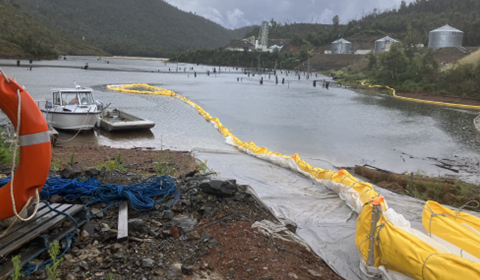
Silt curtains play a crucial role in dredging projects by effectively controlling sediment dispersion and minimizing the environmental impacts associated with dredging activities.
1. Containment of Sediment Plumes: Dredging operations often generate significant amounts of sediment that can spread and create turbidity plumes in the water. Silt curtains act as barriers to contain these sediment plumes within the immediate vicinity of the dredging activity, preventing them from spreading to surrounding areas.
2.Protection of Water Quality: Sediment plumes resulting from dredging can adversely affect water quality by increasing turbidity, reducing light penetration, and potentially releasing contaminants trapped in the sediment. Silt curtains help maintain water quality by confining sediment within the dredging area, minimizing its impact on aquatic ecosystems.
3.Preservation of Habitat: Dredging projects in sensitive environments, such as near coral reefs, seagrass beds, or fish spawning areas, require careful sediment control to avoid damaging these habitats. Silt curtains help protect these habitats by preventing sediment from smothering or disrupting delicate ecosystems.
4.Compliance with Environmental Regulations: Dredging projects are subject to stringent environmental regulations aimed at minimizing their impact on aquatic ecosystems. Many regulatory agencies require the use of silt curtains to control sediment dispersion and ensure compliance with water quality standards and habitat protection measures.
5.Reduction of Project Delays: Uncontrolled sediment dispersion can lead to project delays due to regulatory non-compliance, environmental damage, or the need for costly cleanup efforts. Silt curtains help prevent these delays by containing sediment within the dredging area, allowing projects to proceed efficiently and on schedule.
6.Optimization of Sediment Management: Silt curtains can be used in conjunction with sediment control measures such as sediment traps, silt fences, or sediment ponds to optimize sediment management during dredging projects. By containing sediment within a defined area, silt curtains facilitate the efficient removal and disposal of dredged material while minimizing impacts on surrounding waters.
7.
Adaptability to Site Conditions: Silt curtains are available in various sizes, depths, and configurations to accommodate different dredging project requirements and site conditions. They can be deployed in shallow or deep water, in calm or turbulent environments, and customized to specific project needs. For example, JXY has Type I, Type II, Type III and Type IV
Silt Curtains to accommodate different dredging project requirements and also support customization.
silt curtains are highly effective in controlling sediment dispersion in dredging projects, helping to protect water quality, preserve habitat, ensure regulatory compliance, and optimize project efficiency. Their use is essential for mitigating the environmental impacts associated with dredging activities and promoting sustainable management of aquatic resources.
